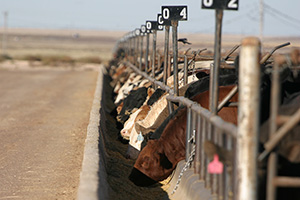CME Group recently announced new changes to help further stabilize the cattle futures market. The new measures are a collaboration of feedback from the cattle industry and an independent analysis conducted by Informa Economics.
“We greatly value our relationship with the cattle community and are committed to helping producers and commercial firms manage their price risk,” Tim Andriesen, CME Group managing director of agricultural products, said in a news release.
To begin the process, CME implemented a cap on the number of messages that could occur per fill in its CME’s messaging efficiency program (MEP). The MEP is designed to ensure efficient messaging that someone doesn’t continually enter orders, modifications and cancellations without trading, according to Feedstuffs. The results showed the number of ratio orders filled in the live cattle futures market decreased by 15 percent, while overall volume was relatively unchanged.
Livestock futures and options trading hours were also reduced to align with the period of greatest liquidity in the markets. They also added a pre-open period for customers to enter, cancel and modify livestock futures and options orders on CME Globex from 2:30-4:00 p.m. CT Monday to Friday.
The biggest change CME has announced will be adding a seasonal discount of $1.50/cwt. on the October live cattle contract for the Worthing, S.D. delivery point, pending CFTC review. The Worthing delivery point currently receives the highest number of deliveries at just over half of all deliveries tendered. This decision came after extensive customer feedback, internal review and Informa’s independent research.
The analysis performed by Informa Economics for CME said the discount “would shift the delivery burden away from areas that have a high percentage of uncommitted cattle to areas that have a lower percentage. Thus, it is reasonable to conclude that practical deliverable supply would decrease to some degree in October if the discount on Worthing is enacted.”
CME is also increasing quality grades seen in all major fed cattle regions. The grading changes will be made for both live and carcass-graded deliveries 55 percent Choice and 45 percent Select to 60 percent Choice and 40 percent Select. These changes are also pending regulatory reviews for the October 2017 contracts.
The group also announced it will delay listing of additional contracts. Cash markets only make up 20 percent of cattle sales and less than 5 percent in major states like Texas and Oklahoma. The decision was made to delay listing any additional contract beyond October 2017 as they continue working with the industry to evaluate ways to improve cash market transparency, review cash market developments and consider the introduction of cash-settled products.


Maybe a lot of the agricultural people understand this language, but to me all I understand is that the price of our cattle is going down, but the price of the feed is not. In our area there has not been any reduction in production of crops, so we are having a little bit of trouble understanding why the prices of cattle has dropped, but feed has actually gone up.
Do you have any comments on this???
thank you,
Hello, Judy. I’d say a lot of ranchers are feeling that same vibe. Local beef prices are influenced by many factors including local weather conditions, national currency strength and global trade with other countries. It’s tough to balance a good value between consumers, farmers and ranchers where everyone is happy.
But as you eluded to, livestock owners can help themselves by managing their input costs.
I’d also consider shopping around and talking with your AgriLife Extension agent if you’re not satisfied with feed prices. There may be another option available that fit the needs of your livestock and that’s worth investigation.